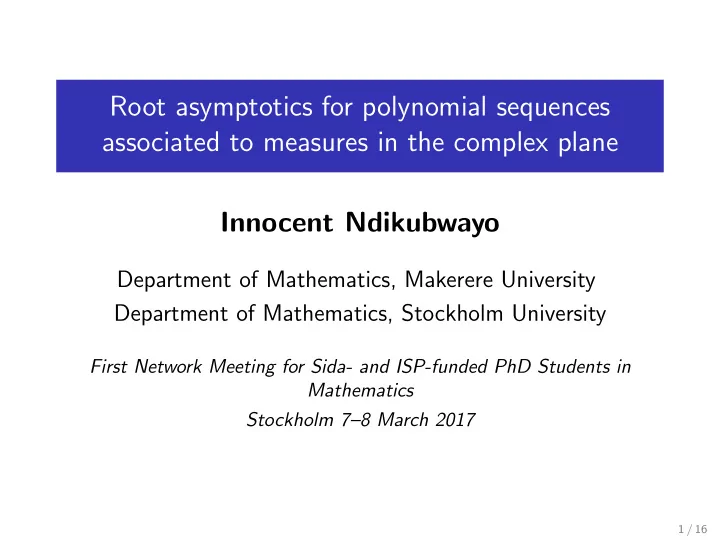

Root asymptotics for polynomial sequences associated to measures in the complex plane Innocent Ndikubwayo Department of Mathematics, Makerere University Department of Mathematics, Stockholm University First Network Meeting for Sida- and ISP-funded PhD Students in Mathematics Stockholm 7–8 March 2017 1 / 16
My Advisors Boris Shapiro Rikard Bogvad David Sseviirri Alex Bamunoba Main advisor Assistant advisor Main advisor Assistant advisor Stockholm Univ Stockholm Univ Makerere Univ Makerere Univ 2 / 16
Research Topic Root asymptotics for derivatives of linearly increasing order for a polynomial sequence associated to measure in a complex plane. 3 / 16
Introduction The project is about studying asymptotic distribution of zeros of sequences of univariate polynomials and the distribution of zeros of their derivatives of higher order. Gauss-Lucas Theorem gives a geometrical relation between the roots of a polynomial P and the roots of its derivative P ′ . The theorem states that the roots of P ′ all lie within the convex hull of the roots of P . 4 / 16
Introduction ct’d There have been refinements of this result but in general the study of location of the critical points w.r.t the zeros of the original polynomials remains active area. Two major challenging open problems are Sendov’s conjecture and Smale’s conjecture. Sendov’s conjecture : For a polynomial P ( z ) = ( z − z 1 ) · · · ( z − z n ) , ( n ≥ 2) with all roots z 1 , · · · , z n inside the closed unit disk | z | ≤ 1, each of the n roots is at a distance no more than 1 from at least one critical point. Conjecture has not been proven for n > 8. 5 / 16
Introduction ct’d Smale’s conjecture : Let P be a monic polynomial of degree n ≥ 2 such that P (0) = 0 and P ′ (0) � = 0. Let w 1 , w 2 , · · · , w n − 1 be its critical points. Then � P ( w i ) � � � � ≤ NP ′ (0) min � � w i i � holds for N = 1 (or n − 1 n ). He also pointed out that the number n − 1 would, if true, be n the best possible bound. The conjecture has been verified for n = 2 , 3 , 4 . 6 / 16
Introduction ct’d Our problem formulation is more from the point of view of random polynomials. Given a probability distribution, take sequence of polynomials with zeros independently chosen according to the distribution. Known result : Given a distribution with compact support and a sequence of polynomials with zeros independent random variables according to the distribution, then the distribution of zeros of first derivatives is the same(in the mean) as of original distribution. 7 / 16
Examples In a non random set-up, the distribution may be different. Example. P ( z ) = z n − 1 with P ′ ( z ) = nz n − 1 8 / 16
Problem We want to consider a situation of increasing the order of differentiation along a sequence of polynomials. Given a probability measure µ supported in some domain. Take a sequence of random polynomials { P n } ; n − 1 � P n ( z ) := ( z − z i , n ) , deg P n = n , i =0 whose roots are iid random variables distributed according to µ . For a given positive number α < 1, we form the sequence { R α n } of its derivatives of increasing order, where n ( z ) := P ([ α n ]) R α ( z ) . n We want to describe root asymptotics of the sequence { R α n } . 9 / 16
The zeros of polynomial P of degree 1592 10 / 16
The zeros of polynomial P (1592) (1000) 11 / 16
The zeros of polynomial Q of degree 2259 12 / 16
The zeros of polynomial Q (2259) (2066) 13 / 16
Zeros of P with deg(P)=200 zeros of P (200) (150) 2 anglen=4.nb Im 3.0 2.5 2.0 Out[49]= 1.5 1.0 0.5 0.0 0.0 0.5 1.0 1.5 2.0 2.5 14 / 16
Impact and Application of the Research As a result of our research we hope to obtain an interesting flow on the space of probability measures with compact supports which connects any such measure to a measure concentrated at its mass center. Such flows might find interesting applications both in potential theory and dynamical systems. 15 / 16
Tack s˚ a mycket! Thank you! 16 / 16
Recommend
More recommend